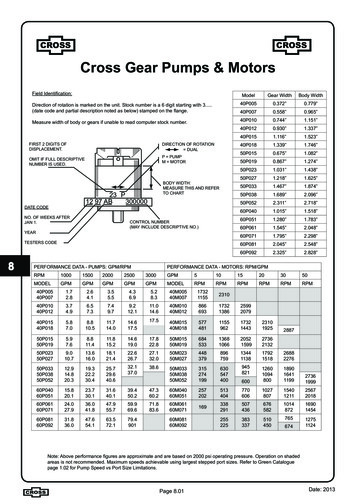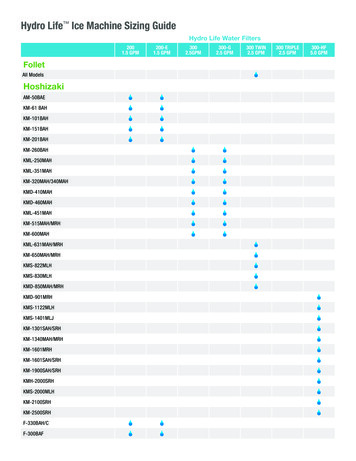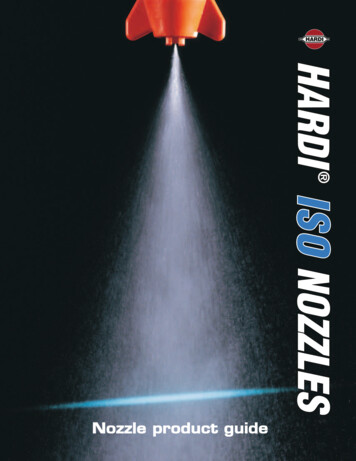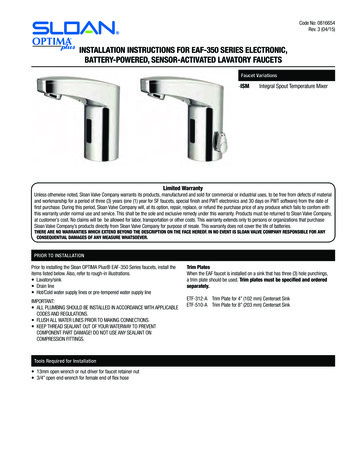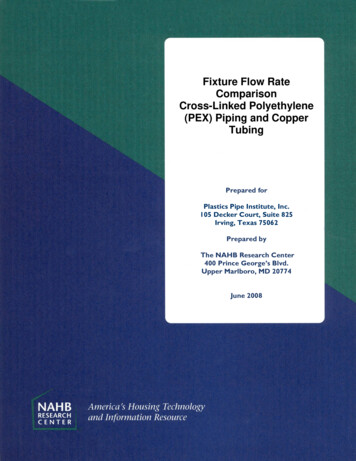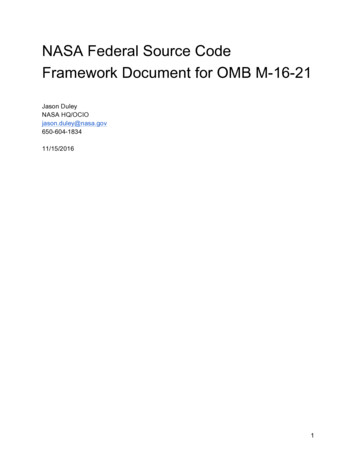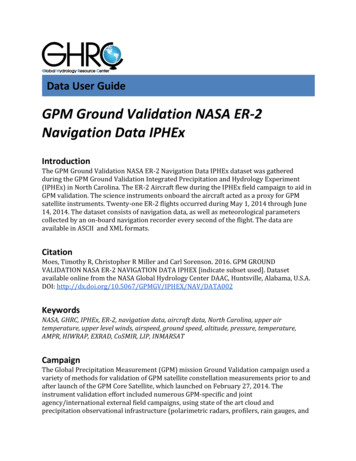
Transcription
Data User GuideGPM Ground Validation NASA ER-2Navigation Data IPHExIntroductionThe GPM Ground Validation NASA ER-2 Navigation Data IPHEx dataset was gatheredduring the GPM Ground Validation Integrated Precipitation and Hydrology Experiment(IPHEx) in North Carolina. The ER-2 Aircraft flew during the IPHEx field campaign to aid inGPM validation. The science instruments onboard the aircraft acted as a proxy for GPMsatellite instruments. Twenty-one ER-2 flights occurred during May 1, 2014 through June14, 2014. The dataset consists of navigation data, as well as meteorological parameterscollected by an on-board navigation recorder every second of the flight. The data areavailable in ASCII and XML formats.CitationMoes, Timothy R, Christopher R Miller and Carl Sorenson. 2016. GPM GROUNDVALIDATION NASA ER-2 NAVIGATION DATA IPHEX [indicate subset used]. Datasetavailable online from the NASA Global Hydrology Center DAAC, Huntsville, Alabama, U.S.A.DOI: eywordsNASA, GHRC, IPHEx, ER-2, navigation data, aircraft data, North Carolina, upper airtemperature, upper level winds, airspeed, ground speed, altitude, pressure, temperature,AMPR, HIWRAP, EXRAD, CoSMIR, LIP, INMARSATCampaignThe Global Precipitation Measurement (GPM) mission Ground Validation campaign used avariety of methods for validation of GPM satellite constellation measurements prior to andafter launch of the GPM Core Satellite, which launched on February 27, 2014. Theinstrument validation effort included numerous GPM-specific and jointagency/international external field campaigns, using state of the art cloud andprecipitation observational infrastructure (polarimetric radars, profilers, rain gauges, and
disdrometers). These field campaigns accounted for the majority of the effort andresources expended by GPM GV. More information about the GPM mission is available athttps://pmm.nasa.gov/GPM/.One of the GPM Ground Validation field campaigns was the Integrated Precipitation andHydrology Experiment (IPHEx) which was held in North Carolina during 2013 and 2014with an intense study period from May 1 to June 15, 2014. The goal of IPHEx was tocharacterize warm season orographic precipitation regimes and the relationship betweenprecipitation regimes and hydrologic processes in regions of complex terrain. The IPHExcampaign was part of the development, evaluation, and improvement of remote-sensingprecipitation algorithms in support of the GPM mission through NASA GPM GroundValidation field campaign (IPHEX GVFC) and the evaluation of Quantitative PrecipitationEstimation (QPE) products for hydrologic forecasting and water resource applications inthe Upper Tennessee, Catawba-Santee, Yadkin-Pee Dee, and Savannah river basins (IPHEXHAP, H4SE). NOAA Hydrometeorology Testbed (HTM) has synergy with this project. Moreinformation about IPHEx is available at https://pmm.nasa.gov/IPHEx igure 1: Region of North Carolina IPHEx campaign ground validation(image source: http://gpm-gv.gsfc.nasa.gov/Gauge/)Instrument DescriptionFor the IPHEx field campaign, NASA’s Airborne Science ER-2 Aircraft was equipped withmulti-frequency-radiometers (AMPR and CoSMIR) and multiple radars (CRS, EXRAD,HIWRAP) and functioned as an expanded GPM Core satellite proxy. The on-boardnavigation recorder on the ER-2 recorded date, time, latitude and longitude, and altitude aswell as wind speed, wind direction, and temperature at one second intervals throughoutthe length of the flight.More information about the ER-2 Aircraft can be found Sheets/FS-046-DFRC.html.
Figure 2: NASA ER-2(Image source: NASA Armstrong ER-2 Fact Sheet)Figure 3: Location of IPHEx remote sensing instruments on the NASA ER-2 aircraft.The blue boxes label the instruments onboard, and the purple circles indicate which GPMSatellite instrument they can simulate.(Image source: IPHEx Science Plan)InvestigatorsTimothy R. Moes
NASA Dryden Flight Research CenterEdwards, CaliforniaChris R. MillerNASA Dryden Flight Research CenterEdwards, CaliforniaCarl SorensonNASA Dryden Flight Research CenterEdwards, CaliforniaData CharacteristicsThe GPM Ground Validation NASA ER-2 Navigation Data IPHEx dataset files consist ofnavigation and meteorological measurements. These data were collected from ER-2 flightsthat occurred from May 1, 2014 through June 14, 2014 and are a Level 1A processing level.More information about the NASA data processing levels are available on the NASA DataProcessing Levels website. Table 1 shows the characteristics of the dataset.Table 1: Data SA ER-2 AircraftVarious navigation and pressure, wind and temperatureInstrumentsensing instruments on the aircraftProjectionn/aSpatial CoverageN: 46.7 , S:26.8 , E: -71.61 , W: -121.85 (North Carolina)Temporal CoverageMay 1, 2014 - June 14, 2014, 1 file per flightTemporal ResolutionHourly - DailySampling FrequencysecondParameterAircraft and Atmospheric conditionsVersion1Processing Level1AFile Naming ConventionThe GPM Ground Validation NASA ER-2 Navigation Data IPHEx data files have the filenaming convention shown below. The data files are available in ASCII and XML formats.Data files: iphex naver2 [IWG1 log] start time end time .[txt xml]Table 2: File naming convention variablesVariableDescriptionIWG1: The IWG1 is a specific style of file used for[IWG1 log]aircraft navigation. Platform characteristics areprovided over time of the flight, in either ASCII or XML
format start time end time [txt xml]Log: Logs of the instrument activation during the flightStart and end time of the flight as YYYYMMDD-hhmm, inUTC where:YYYY four-digit yearMM two-digit monthDD two-digit dayhh two-digit hourmm two-digit minuteNote: xml file does not contain end time in filename.txt: ASCII and ASCII-IWG1 formatsxml: XML formatData Format and ParametersThe GPM Ground Validation NASA ER-2 Navigation Data IPHEx data are available in ASCIIand XML format. The data processing level for these data is 1A. More information aboutNASA data processing levels can be found at: cts/The data files contain platform characteristics of the NASA ER-2 aircraft while in flightduring the IPHEx field campaign. There is 1 file per ER-2 flight. The IWG is a particular styleof ASCII file often used for aircraft navigation data. For more information, see the UCARIWG1 specifications .Table 3 describes the data fields of the IPHEx ER-2 files. Each line represents 1 second ofthe flight, so there will be entrees where not every field has a value. For more informationabout the data format and parameters, see the PI Documentation.Table 3: Data FieldsField NameDate/TimeLatLonGPS MSL AltWGS 84 AltPress AltRadar AltDescriptionISO-8601 formatted date andtimePlatform Latitude in decimaldegreesPlatform Longitude in decimaldegreesGPS Altitude, Mean Sea Level(MSL)WGS 84 Geoid AltitudePressure AltitudeRadar Altimeter AltitudeUnitUTCValid DataRange-degree N-90 to 90degree E-180 to179.9999mmfeetfeetZero or greater
Grnd SpdTrue AirspeedIndicated AirspeedMach NumberVert VelocityTrue HdgTrackDriftPitchRollSide slipAngle of AttackAmbient TempDew PointTotal TempStatic PressDynamic PressCabin PressureWind SpeedWind DirVert Wind SpdSolar ZenithSun Elev ACSun Az GrdSun Az ACGround SpeedTrue AirspeedIndicated AirspeedAircraft Mach NumberAircraft Vertical Velocity(Negative is downward,positive is upward.)True HeadingTrack AngleDrift AnglePitch (Negative is nose down,positive is nose up.)Roll (Negative is left wingdown, positive is right wingdown.)Side Slip AngleAngle of Attack (Negative isnose down, positive is nose up.)Ambient TemperatureDew PointTotal TemperatureStatic PressureDynamic Pressure (total minusstatic)Cabin Pressure / AltitudeWind SpeedWind DirectionVertical Wind Speed (Negativeis downward, positive isupward.)Solar Zenith AngleSun Elevation from AircraftSun Azimuth from GroundSun Azimuth from Aircraftm/sm/sknots--m/s-degrees truedegrees truedegrees0 to 359.99990 to 359.9999-degrees-90 to 90degrees-90 to 90degrees-degrees-90 to 90degrees Cdegrees Cdegrees Cmbar-mbar-mbarm/sdegrees truem/sdegreesdegreesdegrees truedegrees trueZero or greater0 to 359.99990 to 359.99990 to 359.9999SoftwareThese data are available in ASCII and XML format, so no software is required to view thesedata. XML files can be easier to read if opened with Excel and converted to an excel sheet.ReferencesDuke University. (2015). IPHEX-GVFC IPHEx: Integrated Precipitation and HydrologyExperiment. http://iphex.pratt.duke.edu/node/64
Goddard Space Flight Center. (2014). IPHEx Field Campaign Precipitation MeasurementMissions. https://pmm.nasa.gov/iphexUCAR. (2009). IWG1 Packet wgadts/IWG1 Def.htmlRelated DataAll data from other instruments collected during the IPHEx field campaign are related tothis dataset. The following datasets are from the instruments onboard the ER-2 during theflights for the campaign. The full list of IPHEx campaign data can be located using the GHRCHyDRO 2.0 search tool.GPM Ground Validation Conical Scanning Millimeter-wave Imaging Radiometer X/CoSMIR/DATA101 )GPM Ground Validation Cloud Radar System (CRS) TA101 )GPM Ground Validation ER-2 X-band Radar (EXRAD) DATA101 )GPM Ground Validation High-Altitude Imaging Wind and Rain Airborne Profiler (HIWRAP)IPHEx( 01 )GPM Ground Validation Advanced Microwave Precipitation Radiometer (AMPR) ATA202 )Contact InformationTo order these data or for further information, please contact:NASA Global Hydrology Resource Center DAACUser Services320 Sparkman DriveHuntsville, AL 35805Phone: 256-961-7932E-mail: support-ghrc@earthdata.nasa.govWeb: https://ghrc.nsstc.nasa.gov/Updated: June 11, 2018
True_Hdg True Heading degrees_true 0 to 359.9999 Track Track Angle degrees_true 0 to 359.9999 Drift Drift Angle degrees - Pitch Pitch (Negative is nose down, positive is nose up.) degrees -90 to 90 Roll Roll (Negative is left wing down, positive is right wing down.) degrees -90 to 90 Side_slip Side Slip Angle degrees - Angle_of_Attack
